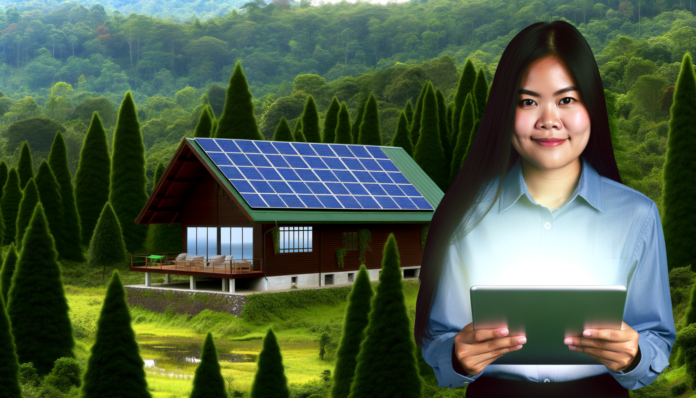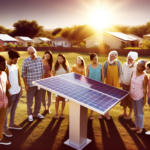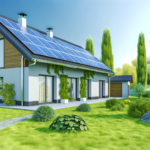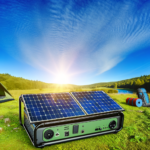Introduction to Off-Grid Solar Power
Understanding Off-Grid Living
Off-grid living refers to a lifestyle that is independent of public utilities, particularly the electrical grid. This means generating your own power, often through renewable energy sources like solar power. Off-grid living is appealing to those who seek self-sufficiency, reduced environmental impact, and freedom from utility bills. It requires careful planning and resource management to ensure a reliable and sustainable energy supply.
Benefits of Solar Power for Off-Grid Living
Solar power is an ideal solution for off-grid living due to several compelling benefits:
- Energy Independence: Solar power allows you to generate your own electricity, reducing or eliminating reliance on external power sources.
- Environmental Impact: Solar energy is a clean, renewable resource that reduces carbon footprints and helps combat climate change.
- Cost Savings: While the initial investment can be significant, solar power systems can save money in the long run by eliminating monthly utility bills.
- Scalability: Solar power systems can be scaled to meet varying energy needs, from small cabins to large homes.
- Low Maintenance: Solar panels require minimal maintenance, making them a hassle-free option for long-term energy production.
Overview of Solar Power Systems
Solar power systems for off-grid living consist of several key components that work together to generate, store, and convert solar energy into usable electricity:
- Solar Panels: These capture sunlight and convert it into direct current (DC) electricity. They are typically mounted on rooftops or open areas to maximize sun exposure.
- Batteries: Energy captured by the solar panels is stored in batteries for use when sunlight is not available. Deep-cycle batteries are commonly used for their ability to discharge and recharge repeatedly.
- Inverters: Inverters convert the DC electricity generated by the solar panels into alternating current (AC) electricity, which is used by most household appliances.
- Charge Controllers: These regulate the flow of electricity from the solar panels to the batteries, preventing overcharging and ensuring efficient energy storage.
- Mounting Systems and Accessories: These include the hardware needed to securely install solar panels and other components, as well as additional accessories like monitoring systems.
By understanding the basics of off-grid living and the benefits of solar power, you can make informed decisions about the type of solar power system that best suits your needs. Whether you are looking to reduce your environmental impact, achieve energy independence, or save on utility costs, solar power offers a viable and sustainable solution for off-grid living.
Assessing Your Energy Needs
Calculating Your Energy Consumption
Understanding your energy consumption is the first step in designing an off-grid solar power system that meets your needs. Begin by listing all the electrical devices and appliances you use daily. Note their wattage and the number of hours each device operates per day. This information is typically found on the device’s label or in the user manual.
To calculate your daily energy consumption, use the following formula:
Energy Consumption (Wh) = Device Wattage (W) × Hours Used Per Day
For example, if you have a 100-watt light bulb that you use for 5 hours a day, it consumes:
100 W × 5 hours = 500 Wh per day
Repeat this calculation for each device and sum the results to get your total daily energy consumption. This figure will help you determine the size of the solar power system you need.
Identifying Essential and Non-Essential Loads
Once you have a clear picture of your energy consumption, the next step is to categorize your electrical loads into essential and non-essential. Essential loads are those that you cannot do without, such as lighting, refrigeration, and communication devices. Non-essential loads include luxury items like entertainment systems and additional lighting.
Creating a prioritized list of your electrical loads helps in designing a system that ensures critical devices remain powered even during periods of low sunlight. This approach also aids in optimizing the size and cost of your solar power system.
Planning for Future Energy Needs
When designing an off-grid solar power system, it’s crucial to consider not only your current energy needs but also potential future requirements. Factors such as family growth, the addition of new appliances, or changes in lifestyle can increase your energy consumption over time.
To plan for future energy needs, consider the following:
– **Scalability:** Choose a solar power system that can be easily expanded. This might involve selecting an inverter and charge controller with higher capacity than currently needed.
– **Energy Efficiency:** Invest in energy-efficient appliances and lighting to reduce overall consumption.
– **Backup Solutions:** Consider integrating a backup generator or additional battery storage to handle unexpected increases in energy demand.
By planning for future energy needs, you ensure that your off-grid solar power system remains effective and reliable for years to come.
Components of a Solar Power System
Solar Panels
Solar panels, also known as photovoltaic (PV) panels, are the cornerstone of any solar power system. These panels consist of multiple solar cells that capture sunlight and convert it into direct current (DC) electricity through the photovoltaic effect. Solar panels are typically installed on rooftops, ground-mounted structures, or even on vehicles, and are angled to maximize sunlight absorption throughout the day.
There are three main types of solar panels:
- Monocrystalline Panels: Known for their high efficiency and durability, these panels are made from a single crystal structure. They are the most efficient but also the most expensive option.
- Polycrystalline Panels: These panels are made from multiple silicon crystals and are generally less efficient than monocrystalline panels but are more budget-friendly.
- Thin-Film Panels: Made from amorphous silicon, these panels are flexible and lightweight, making them ideal for installations on curved surfaces. However, they are the least efficient of the three types.
Solar panels are designed to last for several decades, often up to 25 years or more, making them a long-term investment in renewable energy.
Batteries and Storage Solutions
Batteries are essential for storing the electricity generated by solar panels for use during non-sunny periods, such as nighttime or cloudy days. This is particularly crucial for off-grid systems that rely entirely on stored energy.
There are several types of batteries used in solar power systems:
- Lead-Acid Batteries: These are the most traditional and cost-effective option but require regular maintenance and have a shorter lifespan.
- Lithium-Ion Batteries: Known for their high energy density and long lifespan, these batteries are more expensive but require less maintenance and offer better performance.
- Nickel-Cadmium and Flow Batteries: These are less common but offer specific advantages in certain applications, such as high durability and scalability.
Choosing the right battery depends on your energy needs, budget, and maintenance preferences.
Inverters and Charge Controllers
Inverters and charge controllers are critical components that ensure the smooth operation of a solar power system.
Inverters: The primary function of an inverter is to convert the DC electricity generated by solar panels into alternating current (AC) electricity, which is used by most household appliances. There are different types of inverters:
- String Inverters: These are the most common and cost-effective, suitable for smaller residential systems.
- Microinverters: These offer panel-level optimization, making them ideal for complex roof architectures or shaded areas.
- Power Optimizers: These work similarly to microinverters but are used in conjunction with string inverters to optimize each panel’s performance.
Charge Controllers: These devices manage the flow of electricity from the solar panels to the batteries, preventing overcharging and excessive discharge, which can significantly shorten battery life. There are two main types:
- Pulse Width Modulation (PWM): These are simpler and less expensive but less efficient.
- Maximum Power Point Tracking (MPPT): These are more efficient and can extract the maximum possible power from the solar panels.
Mounting Systems and Accessories
Mounting systems are essential for securely attaching solar panels to rooftops, ground mounts, or poles. The quality and type of mounting system can significantly impact the efficiency and longevity of your solar power system.
Types of mounting systems include:
- Roof Mounts: The most common type, used for residential and commercial buildings. They can also be used on vehicles like RVs and boats.
- Ground Mounts: These are used when roof space is insufficient. They are mounted on concrete piers and can be adjusted manually to optimize sunlight capture.
- Pole Mounts: These raise the panels higher off the ground and can include tracking systems that automatically adjust the panels to follow the sun.
Accessories such as wiring, connectors, and monitoring systems are also crucial for the seamless operation of a solar power system. High-quality components and professional installation ensure the system’s efficiency and durability, maximizing your investment in renewable energy.
Types of Solar Power Systems
Portable Solar Power Systems
Portable solar power systems are designed for mobility and convenience. These systems are ideal for camping, RV trips, or emergency backup power. They typically consist of foldable or compact solar panels, a battery pack, and an inverter. The main advantage of portable systems is their flexibility; you can set them up and take them down as needed, making them perfect for temporary or mobile applications.
**Pros:**
– **Mobility:** Easy to transport and set up.
– **Versatility:** Can be used in various locations and situations.
– **Ease of Use:** Generally user-friendly with plug-and-play features.
**Cons:**
– **Limited Power Output:** Not suitable for powering an entire home.
– **Smaller Battery Capacity:** Limited storage means they can only power small devices or appliances for a short period.
Fixed Solar Power Systems
Fixed solar power systems are permanent installations typically mounted on rooftops or ground-mounted structures. These systems are designed to provide a stable and continuous power supply to a home or business. They consist of solar panels, an inverter, and often a battery storage system. Fixed systems can be either grid-tied or off-grid, depending on your needs.
**Pros:**
– **High Power Output:** Capable of powering an entire home or business.
– **Long-Term Savings:** Significant reduction in electricity bills over time.
– **Reliability:** Provides a consistent and stable power supply.
**Cons:**
– **High Initial Cost:** Requires a significant upfront investment.
– **Permanent Installation:** Not easily moved once installed.
– **Maintenance:** Requires regular maintenance to ensure optimal performance.
Hybrid Solar Power Systems
Hybrid solar power systems combine the best features of both grid-tied and off-grid systems. These systems are connected to the utility grid but also include battery storage. This setup allows you to store excess solar energy for use during power outages or at night. Hybrid systems offer the flexibility of using solar power, battery storage, and grid electricity, making them highly versatile.
**Pros:**
– **Energy Independence:** Reduces reliance on the utility grid.
– **Backup Power:** Provides power during outages.
– **Maximized Efficiency:** Stores excess energy for later use, reducing waste.
**Cons:**
– **High Cost:** More expensive due to the inclusion of batteries.
– **Complex Installation:** Requires professional installation and setup.
– **Maintenance:** Batteries require regular maintenance and eventual replacement.
In summary, the type of solar power system you choose will depend on your specific needs, budget, and lifestyle. Portable systems offer flexibility and ease of use, fixed systems provide a stable and long-term solution, and hybrid systems offer the best of both worlds with added energy independence and reliability.
Choosing the Right Solar Power System for You
Factors to Consider
When selecting a solar power system, several factors must be taken into account to ensure it meets your specific needs. **Location** is crucial; the amount of sunlight your area receives will directly impact the efficiency of your solar panels. **Energy consumption** is another key factor. Understanding your daily, monthly, and annual energy usage will help you determine the size and type of system required. **Budget** constraints also play a significant role, as the initial investment can vary widely depending on the system’s complexity and components. Additionally, consider your **long-term goals**: Are you looking for complete energy independence, or do you want to supplement your existing power supply? Finally, think about **maintenance** and **installation**. Some systems require more upkeep and professional installation, which can add to the overall cost.
Comparing Different Systems
There are three main types of solar power systems: **grid-tied**, **off-grid**, and **hybrid**.
- Grid-Tied Systems: These are connected to the utility power grid, allowing you to use solar energy and electricity from the grid. They are generally the most cost-effective and provide the best return on investment, especially in areas with net metering. However, they won’t provide power during a grid outage.
- Off-Grid Systems: These systems are entirely independent of the utility grid. They require a significant amount of battery storage and often a backup generator. While they offer complete energy independence, they are usually more expensive and require lifestyle adjustments to manage energy consumption effectively.
- Hybrid Systems: Combining elements of both grid-tied and off-grid systems, hybrid systems use batteries to store excess energy while still being connected to the grid. They offer a balance between cost and energy independence, making them ideal for areas with frequent power outages or limited net metering options.
Budgeting for Your Solar Power System
Budgeting for a solar power system involves more than just the initial cost of the panels. **Upfront costs** include solar panels, inverters, batteries, and installation fees. **Long-term costs** should also be considered, such as maintenance, potential repairs, and battery replacements. It’s essential to factor in any **financial incentives** or **rebates** available in your area, which can significantly reduce the overall cost. Additionally, consider the **return on investment (ROI)**. While the initial investment may be high, the savings on your energy bills and potential income from selling excess energy back to the grid can make it worthwhile in the long run. Finally, don’t forget to budget for **unexpected expenses**. Having a financial cushion can help you manage any unforeseen costs that may arise during installation or operation.
By carefully considering these factors, comparing different systems, and budgeting appropriately, you can choose the solar power system that best fits your needs and ensures a sustainable, energy-efficient future.
Installation and Maintenance
DIY vs. Professional Installation
When it comes to installing your off-grid solar power system, you have two primary options: doing it yourself (DIY) or hiring a professional. Each approach has its own set of advantages and considerations.
DIY Installation:
- Cost Savings: One of the most significant benefits of DIY installation is the potential for cost savings. By handling the installation yourself, you can avoid labor costs associated with hiring professionals.
- Learning Experience: Installing your own system can be a valuable learning experience, giving you a deeper understanding of how your solar power system works.
- Flexibility: DIY installation allows you to work at your own pace and make adjustments as needed.
Professional Installation:
- Expertise: Professional installers have the experience and knowledge to ensure that your system is installed correctly and efficiently.
- Warranty and Support: Many professional installations come with warranties and ongoing support, providing peace of mind in case any issues arise.
- Compliance: Professionals are familiar with local regulations and can ensure that your installation meets all necessary codes and standards.
Ultimately, the choice between DIY and professional installation depends on your comfort level with the technical aspects of the installation, your budget, and your desire for professional support.
Basic Maintenance Tips
Maintaining your off-grid solar power system is crucial for ensuring its longevity and efficiency. Here are some basic maintenance tips to keep your system running smoothly:
- Regular Cleaning: Keep your solar panels clean by removing dust, dirt, and debris. This can be done with a soft brush or a hose. Clean panels can capture more sunlight and generate more electricity.
- Inspect Connections: Regularly check all electrical connections for signs of corrosion or wear. Tighten any loose connections to prevent energy loss and potential hazards.
- Monitor Battery Health: Check the health of your batteries periodically. Ensure they are charging and discharging correctly and look for any signs of damage or wear.
- Check Inverter and Charge Controller: Inspect your inverter and charge controller to ensure they are functioning properly. Look for any error messages or unusual behavior.
- Trim Nearby Vegetation: Ensure that trees or other vegetation do not cast shadows on your solar panels, as shading can significantly reduce their efficiency.
By following these basic maintenance tips, you can help ensure that your solar power system operates at peak performance.
Troubleshooting Common Issues
Even with regular maintenance, you may encounter some common issues with your off-grid solar power system. Here are a few troubleshooting tips:
- Low Power Output: If your system is generating less power than expected, check for shading on the panels, dirty panels, or faulty connections. Ensure that your panels are positioned correctly to maximize sunlight exposure.
- Battery Issues: If your batteries are not holding a charge, check the connections and ensure that the charge controller is functioning properly. It may also be time to replace old or damaged batteries.
- Inverter Problems: If your inverter is not working, check for any error messages and consult the user manual. Ensure that all connections are secure and that the inverter is not overloaded.
- System Shutdowns: If your system shuts down unexpectedly, check for tripped breakers or blown fuses. Ensure that your system is not overloaded and that all components are functioning correctly.
By addressing these common issues promptly, you can minimize downtime and ensure that your off-grid solar power system continues to provide reliable energy.
Maximizing Efficiency and Sustainability
Optimizing Solar Panel Placement
Proper placement of solar panels is crucial for maximizing their efficiency. Here are some key considerations:
- Orientation: In the Northern Hemisphere, solar panels should ideally face true south to capture the maximum amount of sunlight throughout the day. Conversely, in the Southern Hemisphere, panels should face true north.
- Tilt Angle: The angle at which panels are tilted should correspond to your latitude. This ensures that the panels receive the most direct sunlight year-round. Adjustable mounts can help optimize the angle seasonally.
- Avoiding Shading: Even partial shading can significantly reduce the efficiency of solar panels. Ensure that trees, buildings, or other obstructions do not cast shadows on your panels, especially during peak sunlight hours.
- Roof vs. Ground Mounting: While roof-mounted systems are common, ground-mounted systems can be adjusted more easily for optimal tilt and orientation. They also allow for easier maintenance and cleaning.
Energy-Saving Tips
Maximizing the efficiency of your solar power system also involves reducing your overall energy consumption. Here are some energy-saving tips:
- Use Energy-Efficient Appliances: Invest in appliances that have high energy efficiency ratings. Look for the Energy Star label when purchasing new appliances.
- LED Lighting: Replace incandescent bulbs with LED lights, which use significantly less energy and have a longer lifespan.
- Insulation and Weatherproofing: Properly insulate your home and seal any drafts to reduce the need for heating and cooling, which are major energy consumers.
- Smart Thermostats: Use programmable or smart thermostats to optimize heating and cooling schedules, ensuring that energy is not wasted when it is not needed.
- Unplug Devices: Many electronic devices consume power even when turned off. Unplugging devices or using power strips to turn off multiple devices at once can save energy.
Staying Updated with Solar Technology
The field of solar technology is rapidly evolving, and staying informed about the latest advancements can help you maximize the efficiency and sustainability of your system:
- New Panel Technologies: Keep an eye on advancements in solar panel technology, such as bifacial panels that capture sunlight from both sides or perovskite solar cells that promise higher efficiency and lower costs.
- Energy Storage Solutions: Battery technology is continually improving. Newer batteries offer higher storage capacities, longer lifespans, and better efficiency. Consider upgrading your storage system as new technologies become available.
- Smart Inverters: Modern inverters come with smart features that allow for better energy management and monitoring. These can optimize the performance of your solar power system and provide valuable insights into your energy usage.
- Software and Apps: Utilize software and mobile apps that provide real-time monitoring and analytics of your solar power system. These tools can help you identify inefficiencies and make data-driven decisions to improve performance.
- Government Incentives and Policies: Stay informed about government incentives, rebates, and policies related to solar energy. These can significantly reduce the cost of upgrading your system and adopting new technologies.
By optimizing solar panel placement, adopting energy-saving practices, and staying updated with the latest solar technologies, you can ensure that your off-grid solar power system operates at peak efficiency and sustainability. This not only maximizes your energy independence but also contributes to a greener and more sustainable future.






